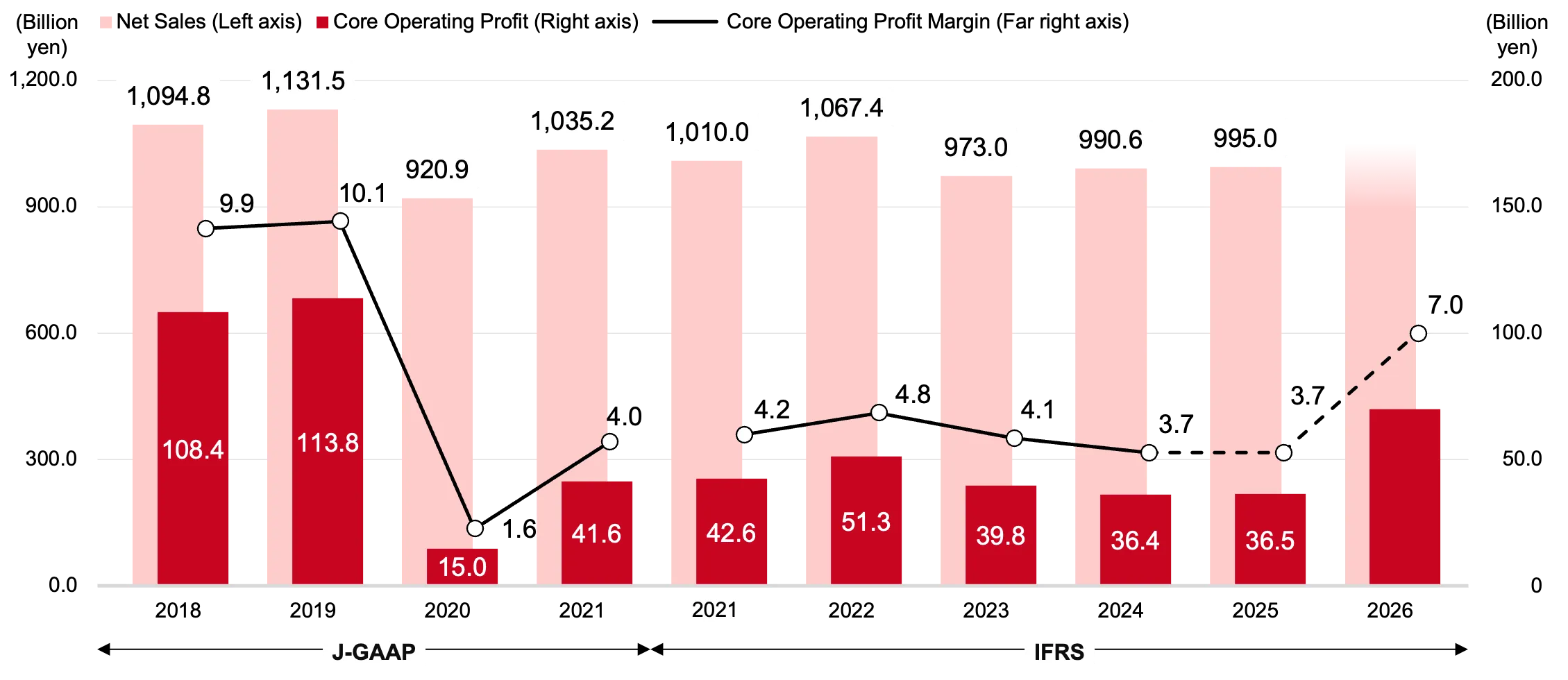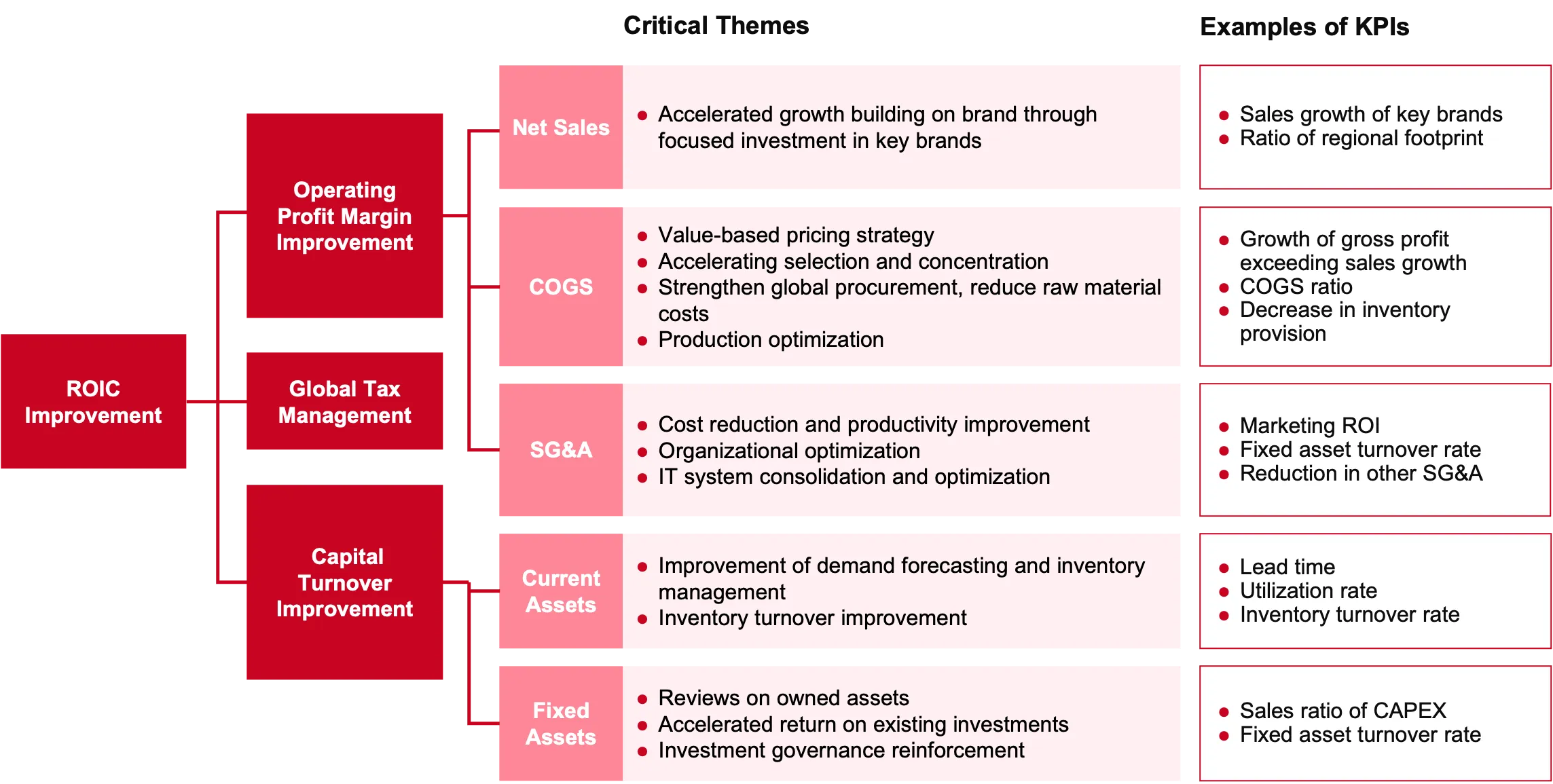On My Appointment as Director and CFO
I assumed the role of CFO in July 2024 and was appointed as a Director in March 2025. After starting my career in the securities industry, I joined Shiseido in 2005, working in Corporate Strategy Division prior to taking on roles including President of our subsidiaries in Indonesia, Head of Strategic Finance, and Head of Investor Relations.
Shiseido is currently facing challenges both in financial performance and market valuation. My mission is to "maximize Shiseido's corporate value by building a strong financial foundation." I am committed to driving transformation and shaping Shiseido's future by engaging actively with our diverse stakeholders.
In particular, I am prioritizing open and constructive dialogue with shareholders and investors. Objective and constructive feedback is critical in shaping management decisions, often providing valuable insights and motivation. Through these discussions, I aim to deepen mutual understanding and enhance shareholder value over the medium-to-long-term.
Core Issues Reflected in Shiseido's Recent Performance
In 2024, despite struggles in our China, Travel Retail, and the Americas Businesses, we achieved our revised core operating profit target in November. However, costs associated with structural reforms and a provision on seller notes![]() resulted in a negative net profit for the year.
resulted in a negative net profit for the year.
Additional costs from the acquisition of Dr. Dennis Gross Skincare further impacted free cash flow. Given these results and the ongoing uncertainty in the business environment, we reduced the year-end dividend to 10 yen per share (annual dividend of 40 yen per share).
Over the past several years, we have fallen behind our medium-term strategic targets with declining profitability and capital efficiency contributing to weak share price performance. I take this situation seriously, and our top priority is to execute all strategic actions and drive earnings recovery to rebuild trust in the capital markets as soon as possible.
Reflecting on the root causes of our weak earnings performances, while external factors such as COVID-19 and China's market slowdown exacerbated challenges, Shiseido's structural issues have also become increasingly apparent: Heavy fixed-cost structure across the organization, lower profitability in the Americas, EMEA, Asia Pacific Businesses, and overreliance on the China and Travel Retail Businesses for profitability. While we have made progress on structural reforms, our management structure must be able to proactively identify issues and implement necessary reforms in advance even when business is performing well.
The current challenging period presents an opportunity to address underlying issues and to strengthen Shiseido's foundations. We are shifting away from market growth-dependent strategies and reinforcing financial governance through: 1) Moving away from overly optimistic, sales-driven asset expansion; 2) Clearly defining brand and regional optimization with focused strategic investments; and 3) Enhancing financial discipline in investment and returns. Our goal is to transform Shiseido into a resilient business that delivers consistent profit growth, regardless of economic conditions.
To that end, the reduction in the year-end dividend for the fiscal year 2024 is a strategic decision that prioritizes financial governance to enhance capital efficiency and shareholder value over the medium to long term. Our key priorities are to improve profitability, expand strategic global investments, execute structural reforms, and to strengthen brand equity. A focus on cash flow discipline and capital efficiency will help us achieve our DOE target of 2.5% or higher, ultimately maximizing shareholder returns and corporate value.
Dividends Trend

Uncompromising Targets Under "Action Plan 2025-2026"
The “Action Plan 2025-2026” is built on two pillars: "reinforcing our brand foundation" and "rebuilding a profitable foundation," both supported by our efforts to "enhance operational governance."
The key to success lies in focused investment strategies that strengthen globally competitive brands and establish sustainable revenue and profit drivers. Over the next two years, we will increase cumulative![]() marketing investment by 30 billion yen, focusing on our Core 3 and Next 5 brands with scale and growth potential. Meanwhile, we will downsize or exit brands with weaker prospects. To build a resilient organization, we will focus on investing in our people and innovation–two of our competitive advantages. Cost structure reform is another critical area. From 2024 to 2025, we will execute over 40 billion yen cost reduction primarily targeting Japan and China, followed by an additional 25 billion yen global fixed cost reduction in 2026, focusing on the Americas and Global HQ. To ensure full benefit realization in 2026, all major actions must be completed within 2025, requiring swift execution.
marketing investment by 30 billion yen, focusing on our Core 3 and Next 5 brands with scale and growth potential. Meanwhile, we will downsize or exit brands with weaker prospects. To build a resilient organization, we will focus on investing in our people and innovation–two of our competitive advantages. Cost structure reform is another critical area. From 2024 to 2025, we will execute over 40 billion yen cost reduction primarily targeting Japan and China, followed by an additional 25 billion yen global fixed cost reduction in 2026, focusing on the Americas and Global HQ. To ensure full benefit realization in 2026, all major actions must be completed within 2025, requiring swift execution.
By 2026, we aim to lower the cost of goods sold (COGS) ratio as well as personnel expenses + other SG&A ratio by two percentage points respectively compared to 2024. This will allow us to achieve a core operating profit margin of 7%, enabling continuous reinvestment. We have deliberately eliminated overly optimistic projections in net sales, planning for a 3% CAGR. At the same time, we will strengthen financial governance, aiming to achieve Return on Invested Capital (ROIC) and Return on Equity (ROE) of 5% and 7% in 2026, respectively. While our ROIC target remains below our assumed weighted average cost of capital (WACC), this serves as a milestone toward double-digit core operating profit margins and a higher ROE in the future.
Targets in 2026
| 2024 | 2026 | |
|---|---|---|
| Sales Growth |
−1% (2023-2024) |
CAGR +3% (2024-2026) |
| Core Operating Profit Margin | 3.7% | 7% |
| ROIC |
0.6% | 5% |
| ROE | −1.7% | 7% |
Four Key Points of Our Financial & Capital Strategy
From a P/L perspective, our focus is on building a profitable and competitive business model by strengthening brand equity. We will also enhance investment governance, striking a balance between aggressive investments ("accelerators") and financial discipline ("brakes") to maximize ROI. To ensure greater transparency in decision-making, we will redefine and implement clear evaluation criteria for different investment types, ensuring precise risk-return assessments.
Additionally, we will reinforce post-investment monitoring, allowing for agile resource reallocation and swift exit decisions when necessary. We will also be placing more emphasis on balance sheet (B/S) management, while maintaining appropriate financial leverage to sustain an A credit rating and secure low-cost, flexible funding sources when opportunities arise. This includes adopting an asset-light approach, optimizing our manufacturing and production lines, and re-evaluating real estates and office spaces. Furthermore, we are committed to enhancing sustainable cash generation and maximizing shareholder value. A key part of this is fostering a cash-conscious culture across the organization and overhauling performance management to strengthen capital efficiency. The FOCUS![]() project which aims to improve our productivity and efficiency, serves as a foundation for these initiatives. This company-wide transformation is set to go-live globally in the second half of 2025, integrating with business process improvements. While this is no small task, successful execution will directly enhance capital efficiency, making this initiative a top priority for the entire company.
project which aims to improve our productivity and efficiency, serves as a foundation for these initiatives. This company-wide transformation is set to go-live globally in the second half of 2025, integrating with business process improvements. While this is no small task, successful execution will directly enhance capital efficiency, making this initiative a top priority for the entire company.
To reduce capital costs, we aim to build a less volatile business, strengthen engagement with shareholders and investors, and enhance transparency in disclosure and sustainability management. For example, in response to investor concerns regarding transfer pricing policy affecting regional performance comparisons, we will update the definition of regional profitability metrics starting with our May 2025 financial disclosures.
These initiatives define our key financial strategy KPIs, including: cash generation (EBITDA and free cash flow), financial soundness (net debt/EBITDA), and capital turnover efficiency (inventory turnover and fixed asset turnover ratios).
Basic Policy on Financial Strategy
| Establish businesses with strong profitability and competitiveness |
|
|---|---|
| Strong balance sheet and maintaining A-rating |
|
| Growing sustainable cash flows and maximizing corporate value |
|
| Lowering WACC |
|
Financial Strategy KPIs
| 2024 | 2026 | ||
|---|---|---|---|
| Improve cash generation capability | EBITDA |
¥89.6 bn | ¥130.0 bn |
| Free Cash Flow | −¥35.3 bn | ¥50.0 bn | |
| Sound financial position | Net D/EBITDA | 1.3× | 1.3× or less |
| Improve capital turnover rate | Inventory turnover rate |
6.4 | 7 |
| Fixed asset turnover rate | 1.8 | 2 |
A Commitment to Driving Results
Shiseido's market capital and financial performance remain under significant pressure. However, I firmly believe in the Company's underlying strength. Since assuming the role of CFO in July 2024, my conversations across the organization have only deepened my commitment to revitalizing Shiseido – a company with a 150 years legacy of resilience, elegance, and innovation. I am dedicated to restoring its shine as a business that not only ensures but continuously creates new value for society.
The rapid recovery in our Japan Business–driven by shifts in organization culture and consumer mindset–has reinforced my confidence that Shiseido will overcome its current challenges and emerge stronger than ever. To reposition Shiseido as a growth-driven company, we must focus relentlessly on execution over the next two years. At the heart of our transformation are our people. This is why embedding ROIC management across the entire organization is our highest priority–it must serve as the bridge between leadership and employees, driving a performance-driven culture. To achieve this, we will break down ROIC into actionable components, link them to departmental KPIs, and establish a system for continuous progress monitoring. In 2025, we will focus on deepening employee understanding and validating the framework, with full-scale implementation scheduled for 2026. However, this initiative will only succeed with employee trust and commitment, which is why ongoing dialogue will be critical to ensure it becomes fully embedded in our culture.
This dialogue will be the key to successful execution of "Action Plan 2025-2026." We will engage in action-oriented discussions with brand holders, regional CEOs and CFOs, ensuring that we move forward with both a strong sense of urgency and a unified vision over the next two years.
This transformation not remain internal—we are committed to enhancing transparency through consistent communication with shareholders and investors. We will provide clear and accountable progress updates, ensuring that our stakeholders are informed every step of the way. I sincerely appreciate your continued support and look forward to frank and constructive discussions as we drive Shiseido’s next phase of growth.





